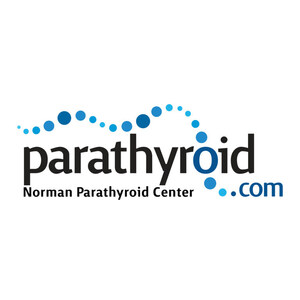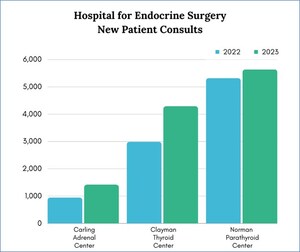TAMPA, Fla., July 6, 2022 /PRNewswire/ -- July is Parathyroid Awareness Month, presenting an opportunity to bring one of the most common ailments of women to the forefront. Despite the common nature of parathyroid tumors, most people are not familiar with the parathyroid glands, what their purpose is or even where they are located in the body. Many are unaware that high blood calcium means a parathyroid tumor is present.
The parathyroid glands are four small glands of the endocrine system which regulate the calcium in our bodies. Parathyroid glands are about the size of a grain of rice and are located in the neck behind the thyroid where they continuously monitor and regulate blood calcium levels. They do this by producing a hormone called Parathyroid Hormone (PTH). Humans and all mammals have 4 parathyroid glands, and we cannot live without them.
Calcium is one of the most important elements in our bodies. Yes, it makes our bones hard, but most importantly, calcium is the element that controls how our nerves conduct electricity. Thus, calcium is the only element in our bodies that has its own regulatory system—the rest are controlled by the kidney. This regulatory system—the parathyroid glands—is quadruple redundant; we have 4 of them.
Hyperparathyroidism (parathyroid disease) is the most common condition of parathyroid glands, caused by the development of a tumor on one or more parathyroid glands. The tumor over-produces PTH causing high blood calcium. Hyperparathyroidism is a very destructive disease that makes people feel poorly while it slowly destroys many tissues of the body.
High blood calcium levels are never normal. Adults over the age of 40 should have all calcium levels below 10.0 mg/dl (below 2.5 mmol/l in Canada and the EU). When the calcium is only a "little bit high" it means a parathyroid tumor is almost certainly present and the destruction has begun.
Parathyroid disease—because of the high blood calcium it causes—affects the brain, bones, kidneys, gastrointestinal tract, nerves, muscles, blood vessels, and heart. It may even increase the risk of certain cancers. The most common symptoms of hyperparathyroidism are chronic fatigue, body aches, difficulty sleeping, bone pain, memory loss, poor concentration, depression, and headaches. Parathyroid disease also frequently leads to osteoporosis, kidney stones, hypertension, cardiac arrhythmias, and kidney failure.
Parathyroid tumors become more common as we age. People of every age get parathyroid disease, but it becomes much more common as you get older. Hyperparathyroidism is most common in patients over 50, and is three times more prevalent in women. In fact, the Norman Parathyroid Center cites that 1 in 50 women will suffer from parathyroid disease at some point in their lives.
Surgery is the only cure. There are no medications that treat hyperparathyroidism. Surgery to remove the parathyroid tumor is the only treatment, and as many as 35% of patients have more than one tumor. As soon as the tumors have been removed, the patient is cured.
Sounds simple, right? Unfortunately, parathyroid glands have the most variable anatomy in the human body and the tumors—about the size of an almond—can be located almost anywhere in the neck. Because it is common for patients to have more than one tumor, it is crucial to check all four glands to ensure the patient is cured. But the parathyroid glands are not always where are they supposed to be, making parathyroid surgery quite tricky in the hands of a general surgeon.
Cure rate is very dependent upon the experience of the surgeon and can be as low as 70% for general surgeons who perform only a few parathyroid operations per year. Additionally, these surgeries traditionally take many hours and are far more invasive than they need to be when performed by inexperienced surgeons.
Minimally Invasive Radioguided Parathyroid (MIRP) Surgery was pioneered by Dr. Jim Norman in the early 90s and is the only method used at the Norman Parathyroid Center. This procedure has by far the highest cure rate (>99%) and is the least invasive of all parathyroid operations, typically lasting between 20 and 30 minutes and allowing patients to go home a few hours after their operation.
"I learned how to perform parathyroid surgery like all surgeons – make a big incision and explore until you find the four parathyroid glands," said Dr. Norman. "As I performed more and more parathyroid surgeries, I couldn't believe that in the era of mini-surgery for gallbladders and knee scope, people had to have their neck cut open to find a tumor the size of an olive. I knew there had to be a better way."
All patients requiring parathyroid surgery are candidates for this minimally invasive procedure, but it is crucial that they find expert surgeons who specialize in this type of operation. About 20% of the Norman Parathyroid Center's business is operating on patients who have had a previous operation by an inexperienced surgeon who now needs a second--or third--operation.
The surgeons at the Norman Parathyroid Center are by far the most experienced parathyroid surgeons in the world performing 70+ parathyroid operations per week. They are the "Dream Team" of parathyroid surgery, made possible when the chief endocrine surgeons from 7 major US universities came together at the new Hospital for Endocrine Surgery with the goal of curing hyperparathyroidism.
"I sought out a second opinion on my hyperparathyroidism diagnosis and was recommended to the Norman Parathyroid Center for its minimally invasive operation," said recent patient Patricia. "I flew to Florida to have the surgeons do exactly what they tell you they will do... cure hyperparathyroidism in about fifteen minutes. The experience is unbelievably simple and comfortable, and I was eating lunch an hour later and touring Busch Gardens the next day. Honestly! My muscle and bone pain started disappearing before I even left Florida two days later. Here I am a month later feeling wonderful. My energy is increasing by the day, and I am back to my healthy "young" self. After the operation, Dr. Norman informed me that I probably had hyperparathyroidism for at least eight years since the tumor on my parathyroid was so large. To think, I could've felt better so much sooner!"
If you or someone you know is suffering from parathyroid disease, do your research. Your chance of being cured is highly dependent on your choice of surgeon, and you are your own best advocate.
"I did my research, and I couldn't find anybody in Pennsylvania that has done 80 of these operations in his lifetime, left alone per week," said recent patient JB. "Their insight and knowledge of this disease far exceeds that of all other doctors. This team is better. This office is better. This system is better. Their operative skills are un-matched. This is the operation you want."
About the Norman Parathyroid Center
Located in Tampa, Florida, the Norman Parathyroid Center is the leading parathyroid gland tumor treatment center in the world, performing nearly 3,800 parathyroid operations annually. Well known for cure rates over 99% via an operation that typically lasts about 20 minutes, the Norman Parathyroid Center's success centers on a teamwork approach by the most experienced parathyroid surgeons in the world.
www.parathyroid.com | (813) 972-0000
Media Contact: Julie Canan, (941) 468-3002, [email protected]
SOURCE Norman Parathyroid Center

WANT YOUR COMPANY'S NEWS FEATURED ON PRNEWSWIRE.COM?
Newsrooms &
Influencers
Digital Media
Outlets
Journalists
Opted In






Share this article